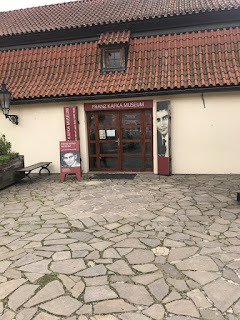She lowers the bucket. “What is your name?”
He tells her. She says, “When I lost my sight, Werner, people said I was brave. When my father left, people said I was brave. But it is not bravery; I have no choice. I wake up and live my life. Don’t you do the same?”
He says, “Not in years. But today. Today maybe I did.”
It pays many times over to persevere with the story of this young girl, Marie Laure, and that of Werner, conscripted as a teenager from a poor, mining town in Germany, gifted at mechanics and physics and telemetry--the science of wireless transmission and tracking of data (Doerr includes in the opening page, this dark quote from Goebbels: "It would not have been possible for us to take power or to use it in the ways we have without the radio.").
Marie Laure loses sight as age six, and she will have to learn to navigate her blindness and the much darker pitch of the war that envelopes her and everything she loves when the Nazis occupy France and the Allied forces invade. Werner, bright blonde but diminutive for his age, is prized for his genius and, after time at a brutal Nazi youth camp, is attached to a special Army unit assigned to ferret out resistance.
Marie Laure’s
father is a locksmith employed by the Museum of Natural History in Paris. They
flee the capital when the Nazi occupation is imminent and embark on an arduous
journey to the seaside town of Saint Malo, to the home of Marie Laure’s reclusive
great-uncle Entienne and his housekeeper. There, the father, surreptitiously
aiding the resistance, constructs the miniature of her new town. The chapters
are short—one imagines the blind learn to navigate by living more closely to
the present moment, one short step at a time, a series of discreet sensory
episodes—and these will keep the reader going.
The same
attention to detail renders viscerally what it is like to live in the eye of
total warfare in a time of siege when the Allied forces invade, the way it
consumes everyone and everything in its path, raining destruction on
everything. I confess to growing frustrated with this story at times (mustn’t
the world be frustrating for the blind, at least when they are young and still
learning to navigate?), especially those scenes of war when Allied bombing is
turning Saint Malo to rubble—so disorienting when Werner and his comrades are
barely staying alive beneath the ruble of a hotel they had been using as a
base. So much darkness, so hard to see.
But it is love, war’s
opposite, that heralds the light, when Werner, escaped from the rubble, witnesses
Marie Laure treading her way perilously through the streets with her cane. He
has seen so much death and destruction, has stood by silently in the face of
enormous cruelty and crime, a teenager himself still, trapped in a murderous
regime. The story begins to fall into place, all the threads coming together,
the dawning light illuminating slowly everything we couldn’t see. In time, Marie
Laure is left to fend for herself alone in her great uncle’s house, pursued by two
German soldiers with very different aims—Werner, who is in love, and a
corpulent and cancer-stricken officer in search of a diamond (said to be a
blessing or a curse or both) that Marie Laure’s father bequeathed to her. The
narrative of this pursuit is a page-turner.
This book is
about many things—bravery and its opposite, kindness and its opposite, love and
war, the immense and gorgeous intricacy of the natural world and its durability
in the face of unnatural forces of destruction. The novel is unsparing in its
depiction of the bottomless and savage cruelty of the Nazis, and it does cause
one to contemplate what must have happened to German society in the years
preceding the war. But this is no polemic about fascism and the story’s German
characters are rendered sympathetically; there is not a polemical word in the
novel. Still, whether Doerr intended it or not, the story is also, I believe, a
powerful anti-war narrative. The beauty of the natural world and of the normal,
natural life Doerr depicts before and long after the war seem pitted against
its opposite—the war, so deeply and profoundly unnatural, so abnormal, so destructive
of normalcy.
Some of us, maybe most, busy ourselves blindly with coping in a world we assume to be
fundamentally adversarial, one in which we assume we are fundamentally alone. But this work is also, finally, about the
connectedness of all things, of all lives, across time. Like Marie Laure and
Werner, our narratives, all of ours, have crossed at some point or will, though
we may never know it in this lifetime. This beautiful novel gives us a glimpse of
a brilliant light that courses through all of time, through all of our lives, whether
we see it or not.














